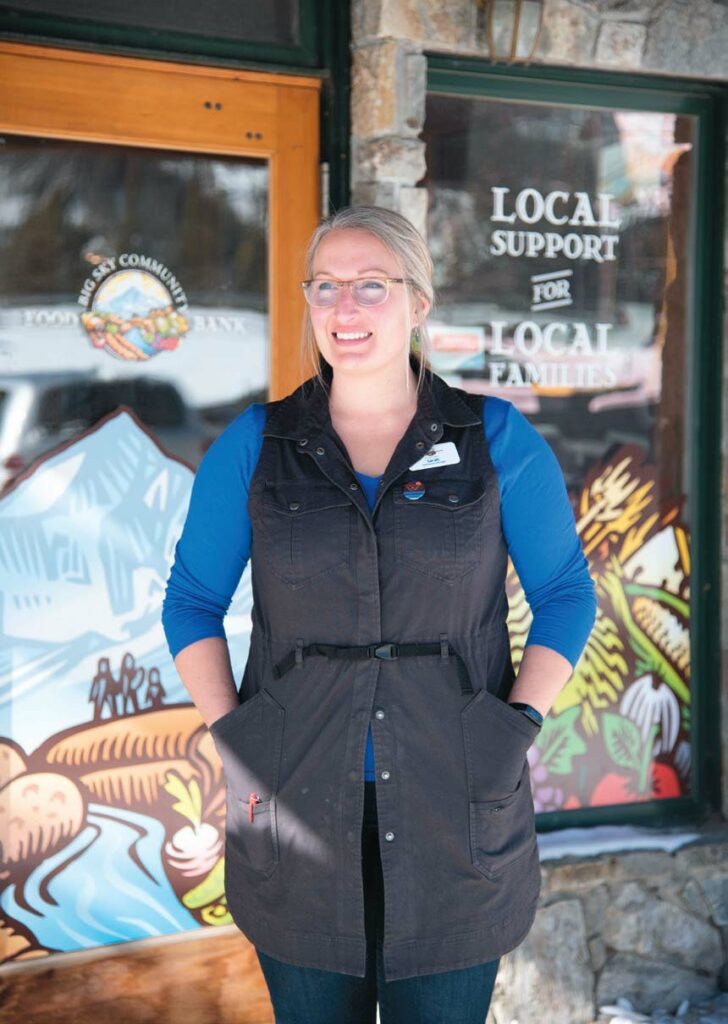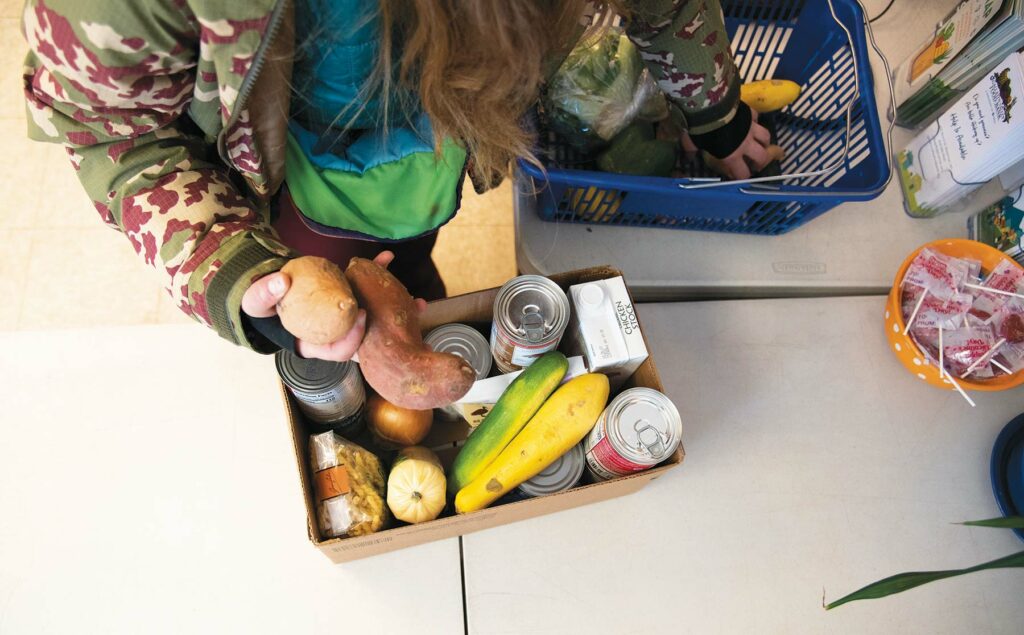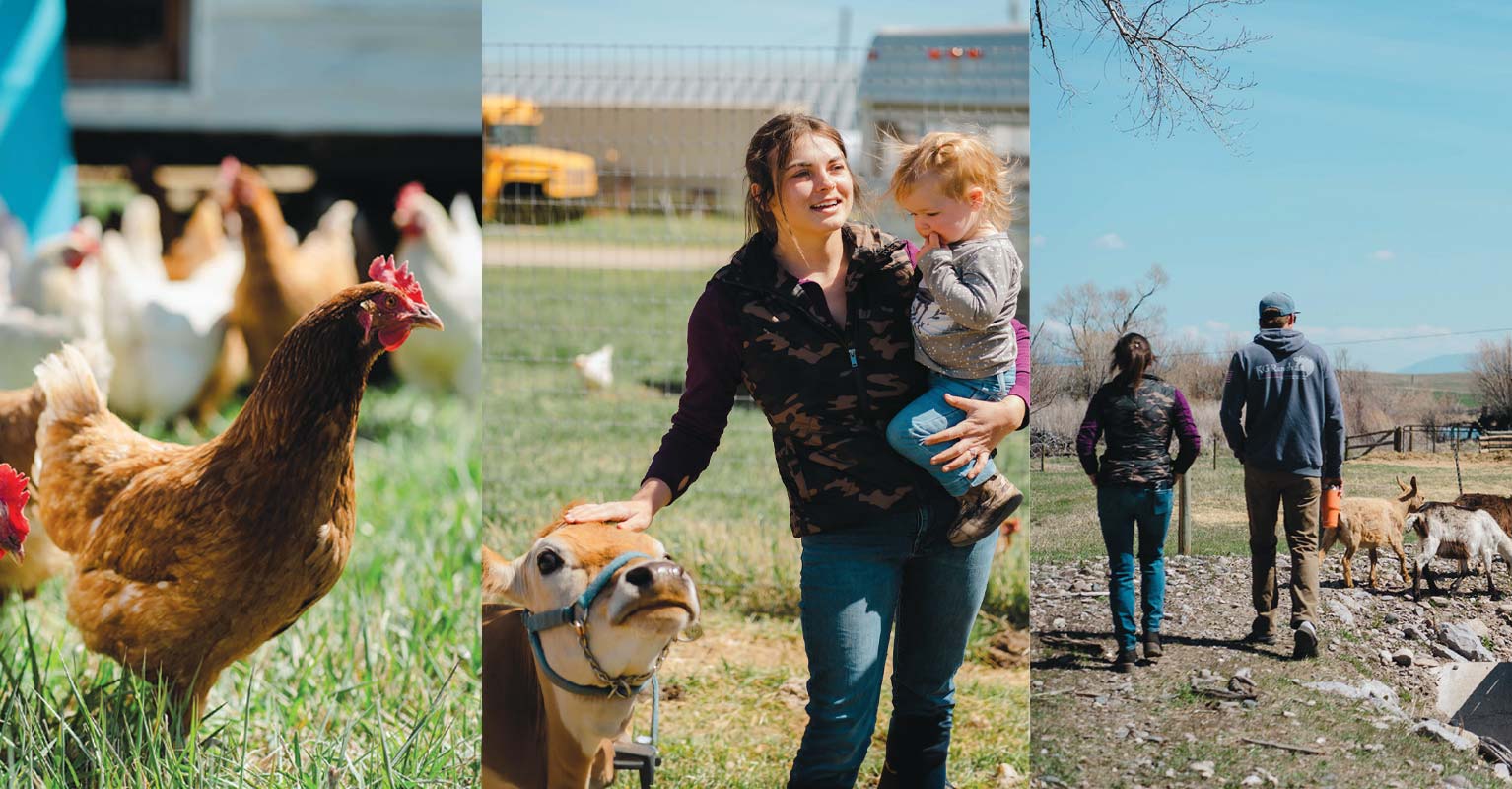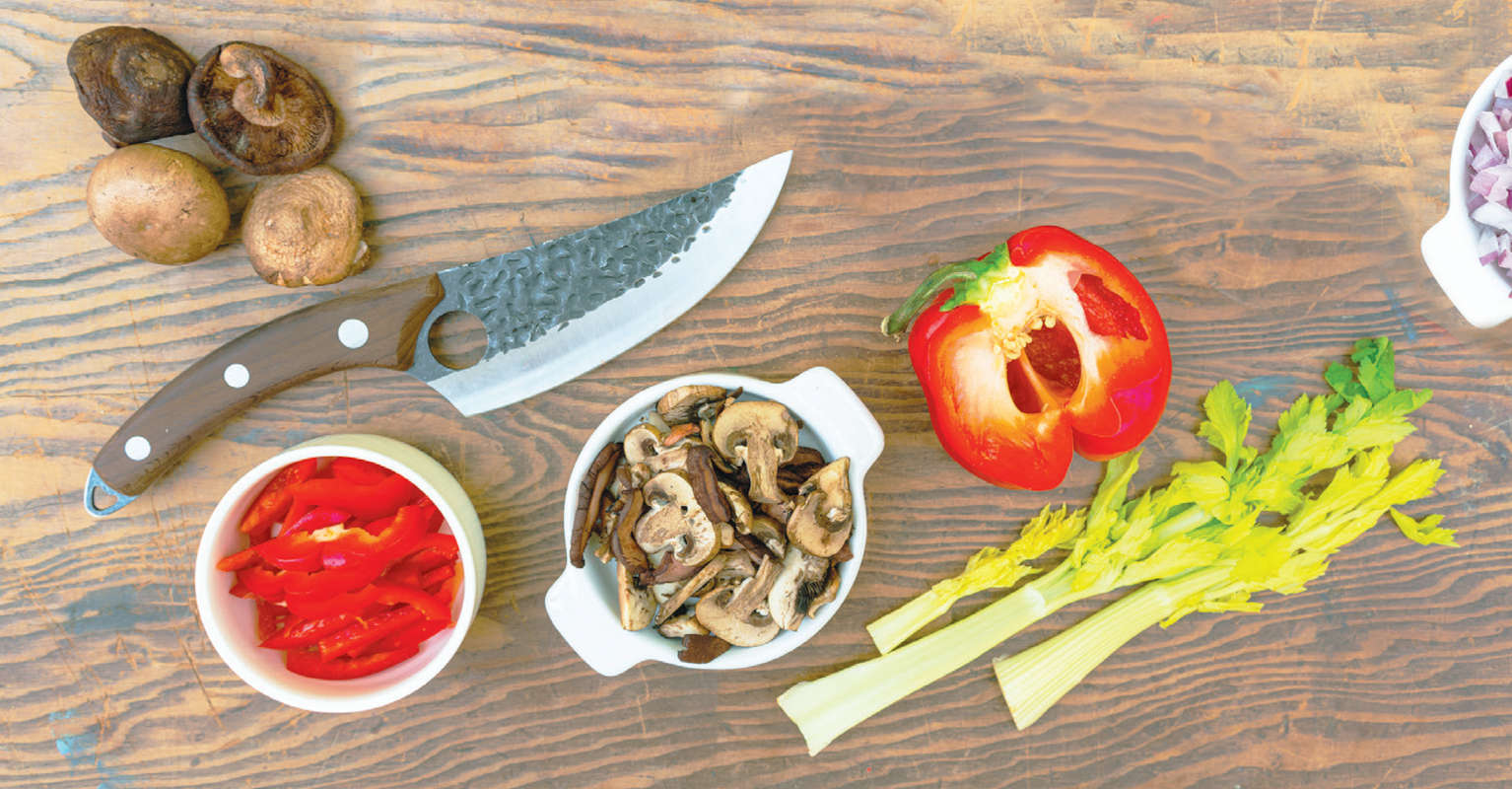A customer at the Big Sky Community Food Bank picks food from a shelf through the pantry’s customer choice model. (below) Operations manager and services navigator Sarah Gaither stands at the food bank entry. She welcomes anyone experiencing food insecurity and is able to provide food to individuals up to twice a month.
The Big Sky Community Food Bank

When Sarah Gaither moved to Big Sky from Skagway, Alaska, in 2012, she had no idea she would end up running the town’s food bank. Needing a steady income to feed her skiing habit, she became the operations manager of the Big Sky Community Food Bank shortly after her move and just after the food bank first opened its doors.
The Big Sky community partnered with Bozeman’s Human Resource Development Council to open the food bank in Big Sky in 2012. Prior to this, food assistance in the area was limited to off-season credit extended at The Country Market and a weekly van sent from the food pantry in Bozeman, which people literally clambered into to pluck out corn, beans, or whatever else was available.
Today, the food bank is an eight-room space with two permanent part-time assistants, a troupe of volunteers, a kitchen, a sorting room, a backstock room, a coat room, and a resource center. “I was the first and only employee until COVID, and then I was able to hire two more people,” says Gaither, who grew up in Portland and holds a master’s degree in leadership for sustainability education. “It was just me for many years. But suddenly 3,000 people [in Big Sky] were out of work, and I knew we were going to need more help.”
A Unique Reality
Big Sky is best known as a resort community. Situated 15 miles from the northwestern border of Yellowstone National Park and roughly halfway between West Yellowstone and Bozeman, the area spans both Gallatin and Madison counties. The small community remained sparsely populated until 1973, when Big Sky Resort opened for its first winter ski season.
Things have snowballed from there. Over the past 50 years, more runs have been added around the original resort, causing Big Sky to evolve from a local ski hill with a tiny hamlet of limited services and few year-round residents to a bustling (though still unincorporated) village. According to the 2020 census, some 3,500 people live in the area, which is well-known for its high-end properties and resort communities. As a tourist hot spot turned residential area, Big Sky now has a medical center, its own school district, grocery stores, gas stations, a bus line, a library, a hardware store, and the food bank.
“My customer base is mostly the seasonal workforce,” Gaither says, adding that the area is strained by expensive housing costs that often drive service workers to seek out housing in other areas as distant as Ennis and Amsterdam. After living and working in Big Sky for six years, Gaither herself fell victim to the housing costs when her landlord turned her condo into an Airbnb. She now lives in Bozeman and commutes.
“Less than 50 percent of my customers live in Big Sky now,” she says, adding that food assistance is an important need in the area. “In 2022, my summer services were up 250 percent from the summer before.” She’s seeing an increase in seasonal workers who commute to Big Sky because they can’t afford to reside where they work, as well as an increase in the number of seniors and families with young children who are seeking assistance.
Gaither says many seasonal workers in the area face a challenging reality: “When your winter job is tied to the ski season, which starts on Thanksgiving day but you have to move into your rental on Nov. 1 and put down first and last month’s rent and a security deposit, you’ve spent all your money moving here. Even from Thanksgiving through the New Year, depending on the snow, you might only be getting part-time work, even though you’re on contract for full-time work.”
Big Sky is also subject to geographical limitations. The area is isolated, with the main access being Highway 191 that winds along the Gallatin River as a two-lane road from Gallatin Gateway to West Yellowstone. It’s time-consuming, costly, and occasionally dangerous to get supplies all the way to Big Sky and, especially in winter, deliveries are not always guaranteed. This drives up the local cost of living, making things like groceries more expensive.
In what would be a win-win for food banks across Montana, House Bill 276, introduced to the Legislature earlier this year, would create a Farm to Food Bank grant program that allocates money to Montana food banks specifically for the purchase of foods from local farmers.

Meeting the Need
There are no prerequisites to shop at the food bank. Anyone experiencing food insecurity is welcome to stop in, and through a customer-choice model people fill out a confidential intake form to record basic demographic information then shop for what they need, up to twice each month.
“I get half of the food from Big Sky—people dropping things off, grocery stores, bakeries, items left in vacation rentals,” Gaither says. “The other half I purchase through the Montana Food Bank Network.” With access to food left behind at vacation rentals, she adds that there’s often quite the selection. “I’ve seen caviar, Trader Joe’s stuff, capers,” she laughs. But, since many food bank customers live in company housing where they may only have a microwave to cook with, canned goods are particularly indispensable. Recognizing that those in need may not have access to full kitchens, Ace Hardware Big Sky donates 100 crockpots annually to the food bank for distribution.
In addition to providing meals, the food bank houses a clothing fix-it center, a resource center with a computer lab, free Wi-Fi, a conference room, and printing services, as well as an expanded community coat room with free winter wear, toiletries, cookware, and linens. Staff provide application support for services like energy assistance, SNAP (food stamps), and unemployment insurance. And, for a small fee, there are even laundry facilities.
The food bank also offers several food-access programs including Senior Groceries, through which qualifying seniors receive canned fruits, vegetables, juice, dairy, proteins, and grains each month; Summer Lunch, where free bagged lunches are provided to anyone 18 and under during summer; and KidsPack, which provides free, nutritious bags of snacks to schoolchildren to take home on the weekends.
Gaither says volunteers, financial donations, and food donations are always welcome. Folks can give to the Voucher Program at The Country Market and to the food bank’s account at the Hungry Moose Market and Deli. Hunters can donate extra game meat to Montana Hunters Against Hunger; diners can eat at Montana’s only pay-what-you-can restaurant, Fork & Spoon in Bozeman; and gardeners can participate in Grow a Row by planting, growing, and donating a set amount of produce, be it fruits, vegetables, or fresh herbs.
In what would be a win-win for food banks across Montana, House Bill 276, introduced to the Legislature earlier this year, would create a Farm to Food Bank grant program that allocates money to Montana food banks specifically for the purchase of foods from local farmers, helping to make local foods accessible to those in need while ensuring farmers are paid a living wage. Supporters of the bill called it an “upstream approach to ending hunger” in their January testimony, citing its support by food banks, farmers, and local food system advocates.
It appears that our beautiful state’s population is going to continue growing and, thanks to the dedication of many, food banks like the Big Sky Community Food Bank are improving access to healthy, nourishing food.
The Big Sky Community Food Bank is open from 3–7 p.m. on Tuesdays and Thursdays, 11 a.m.–3 p.m. on Wednesdays and Fridays, and is closed Saturday through Monday.




